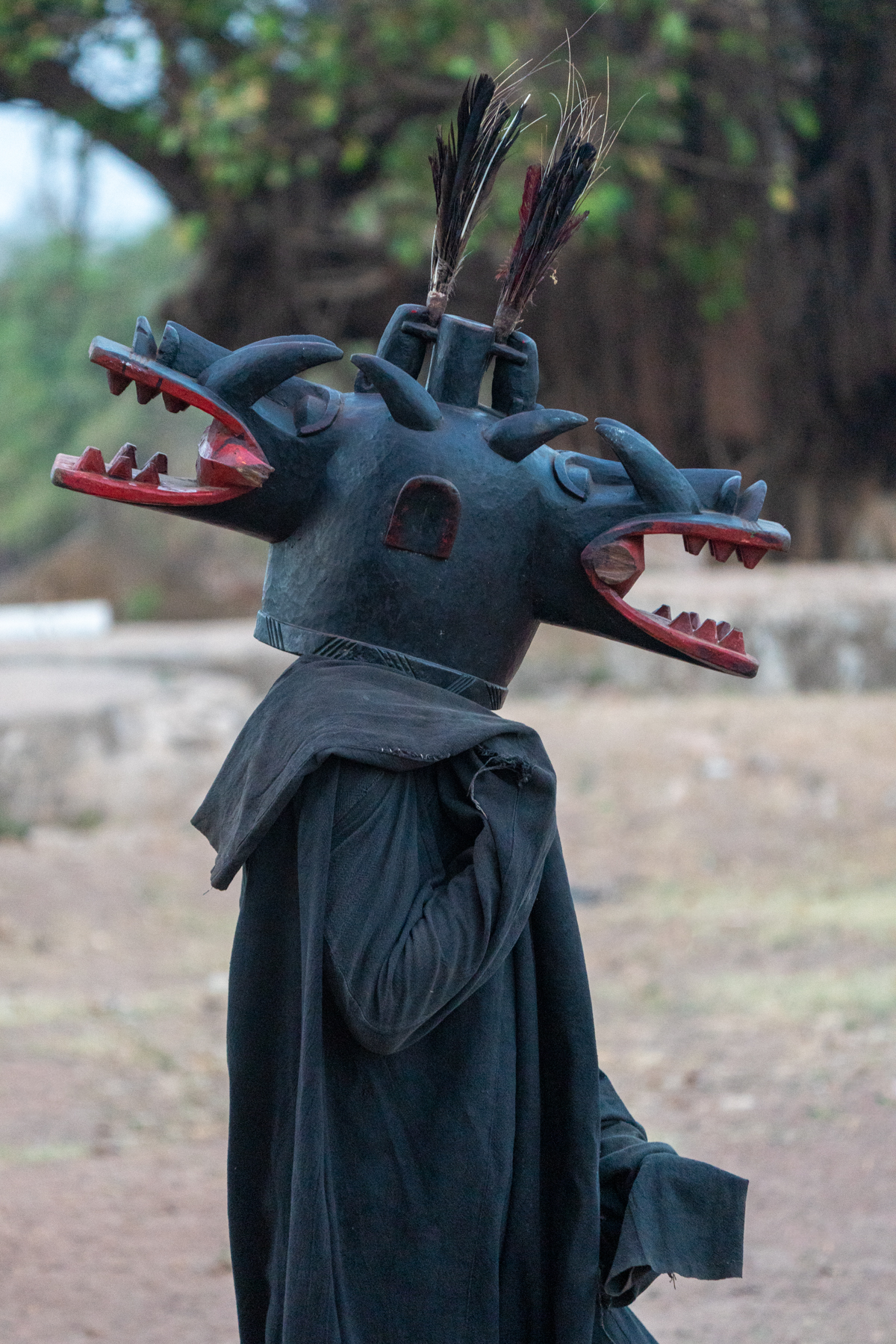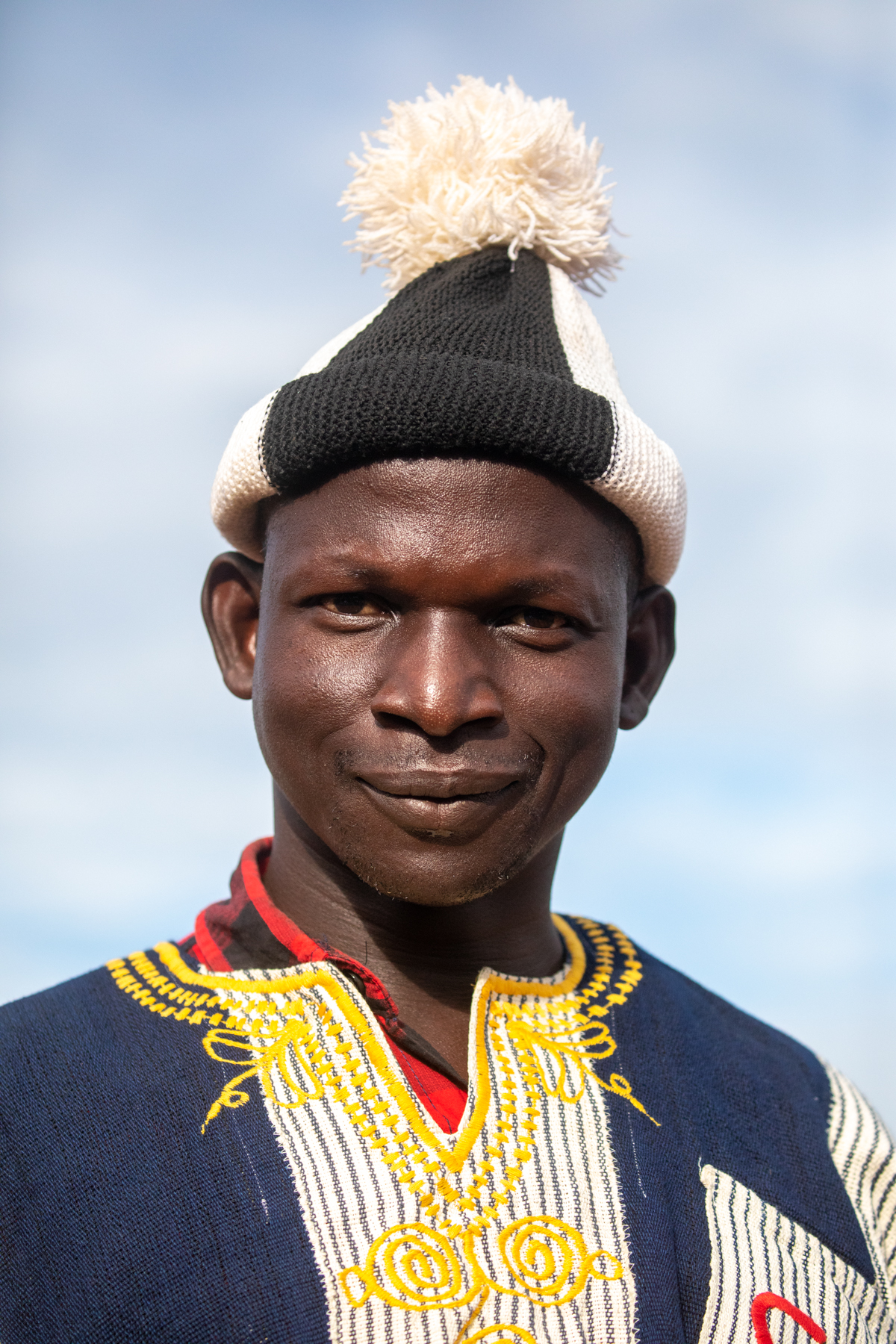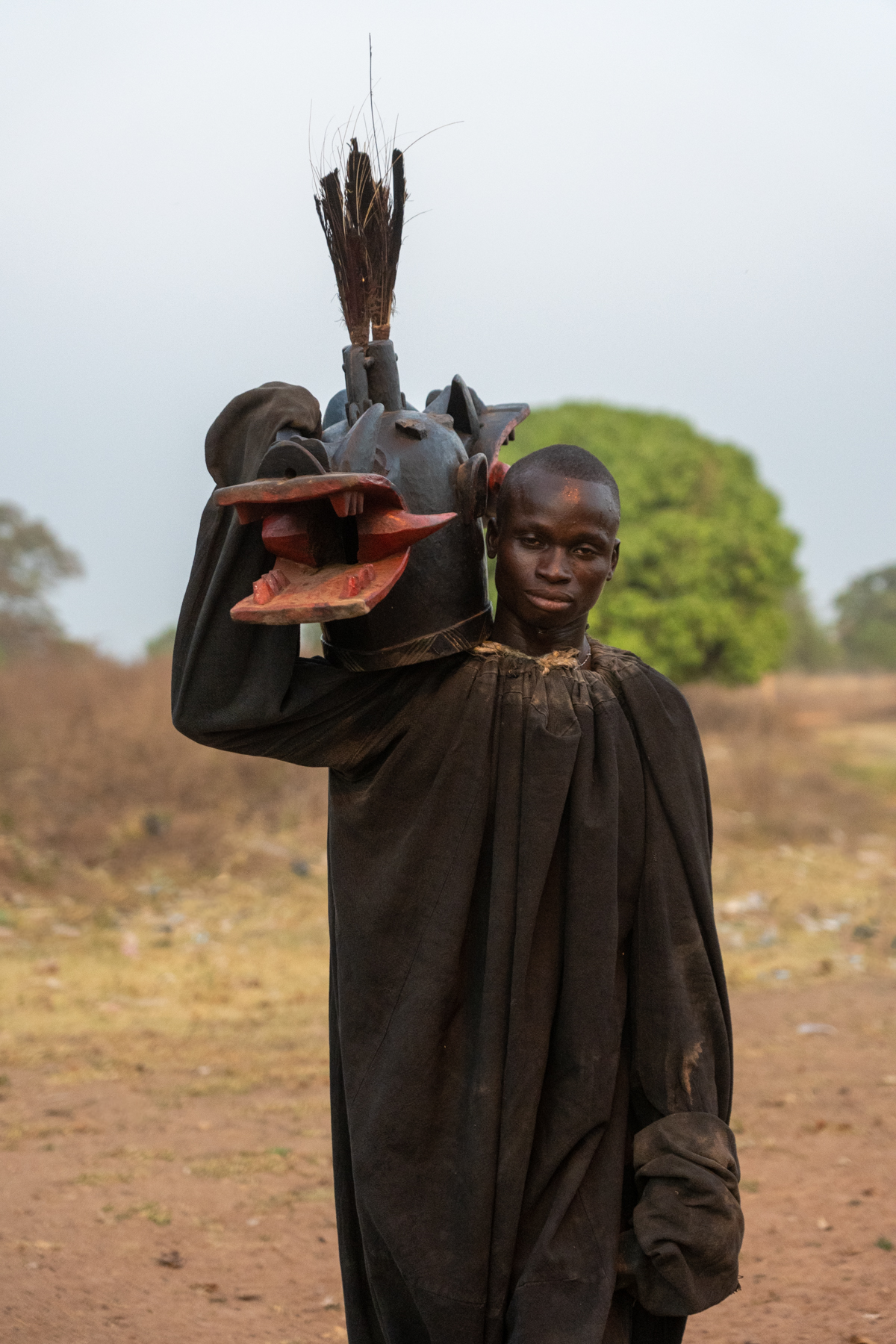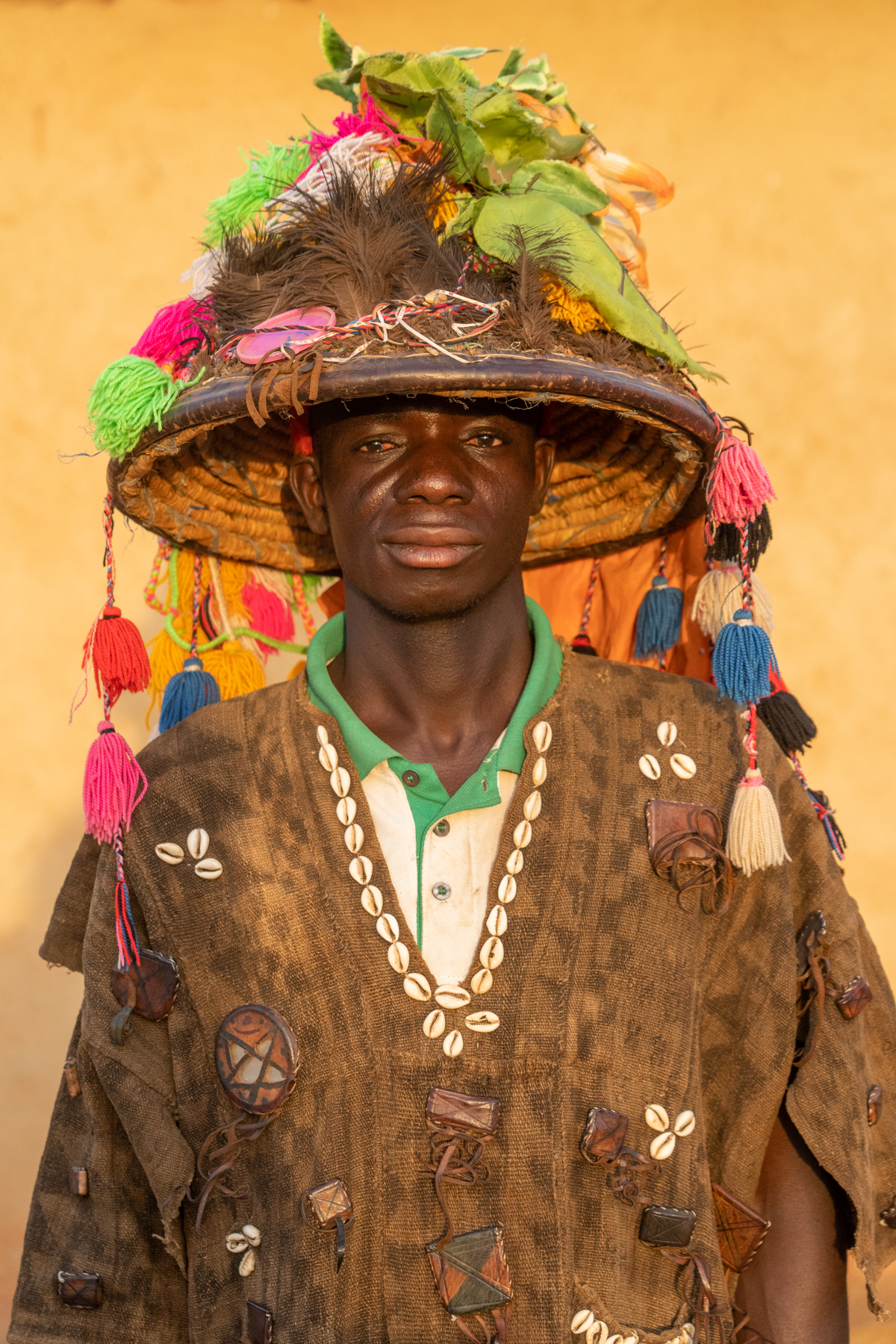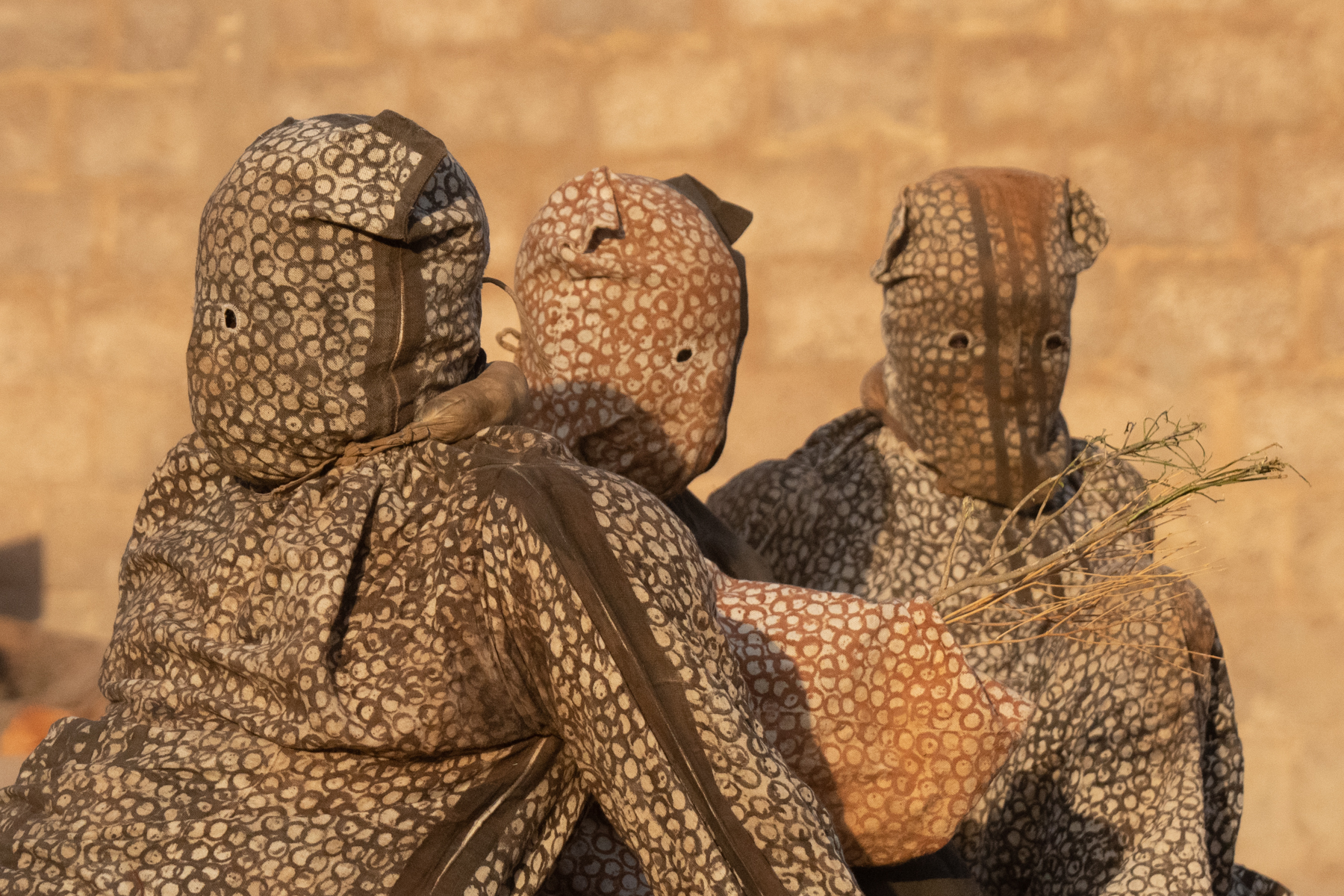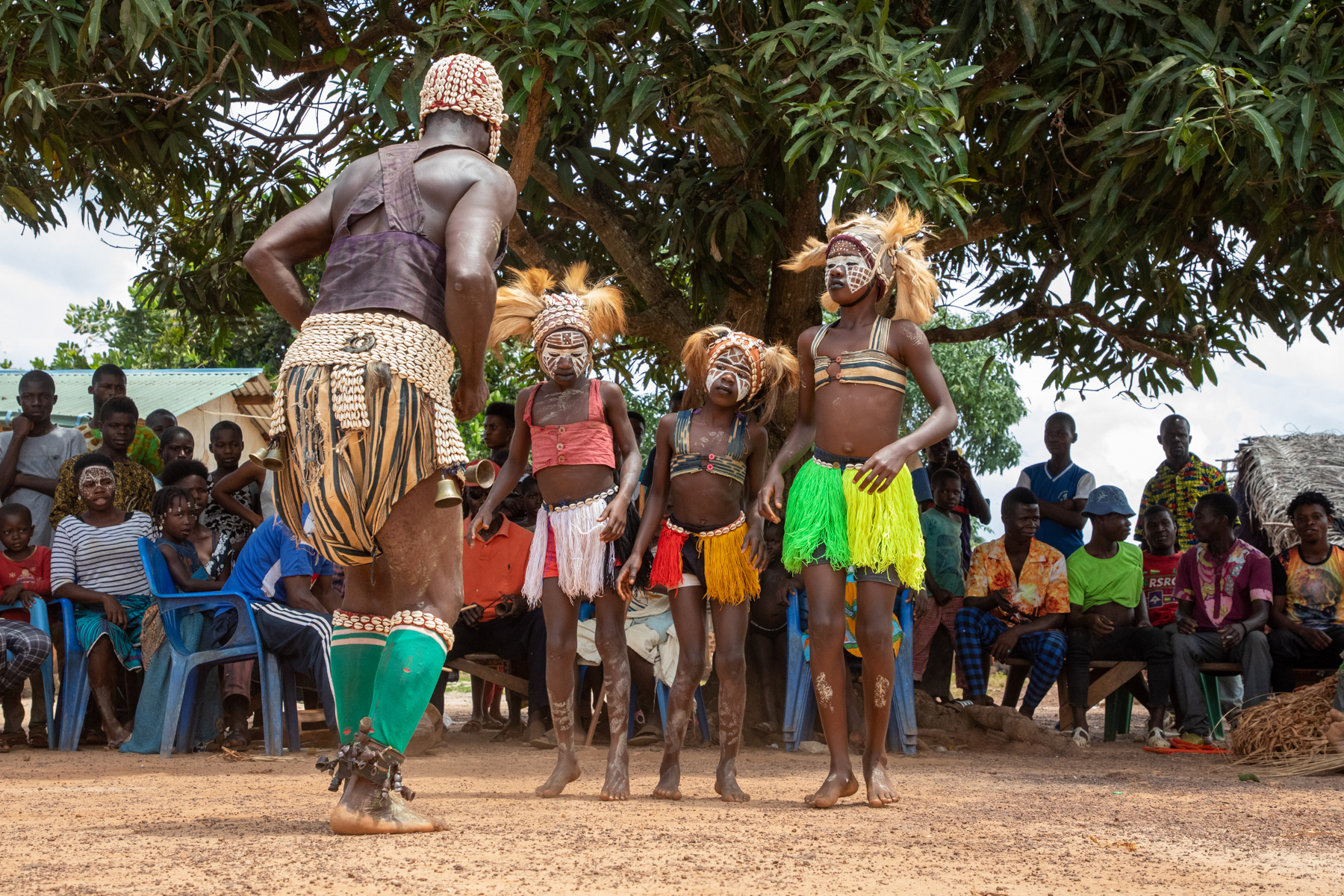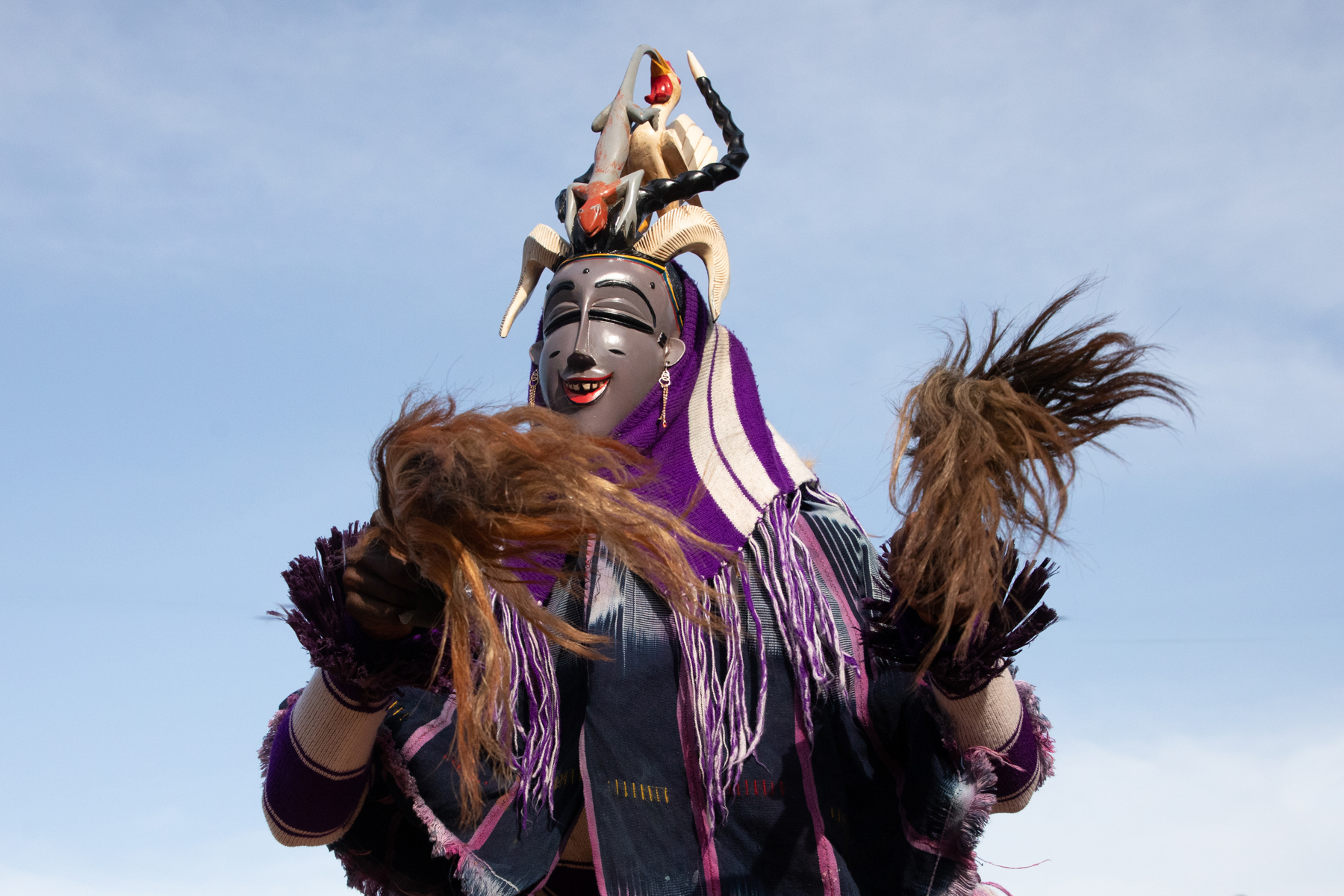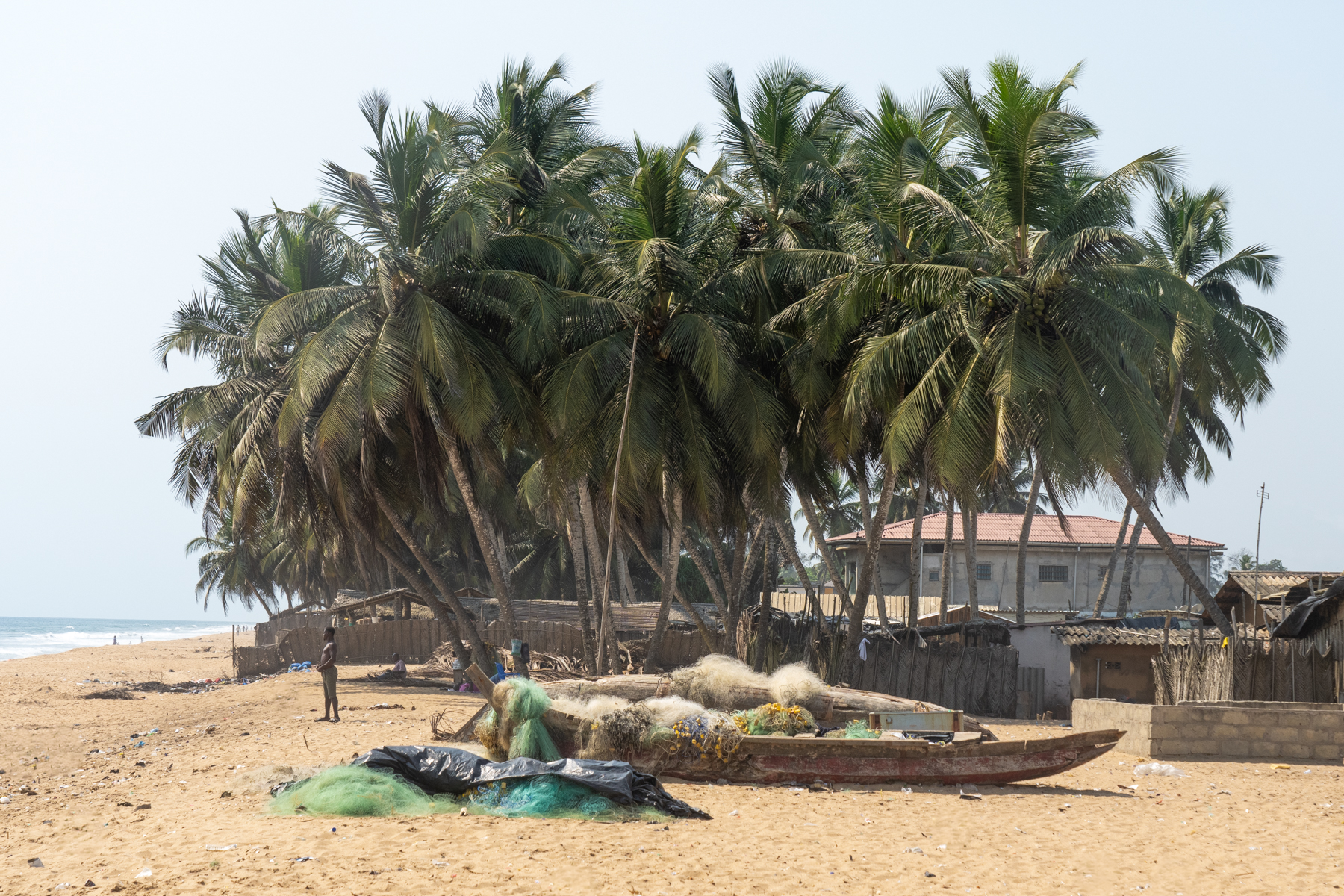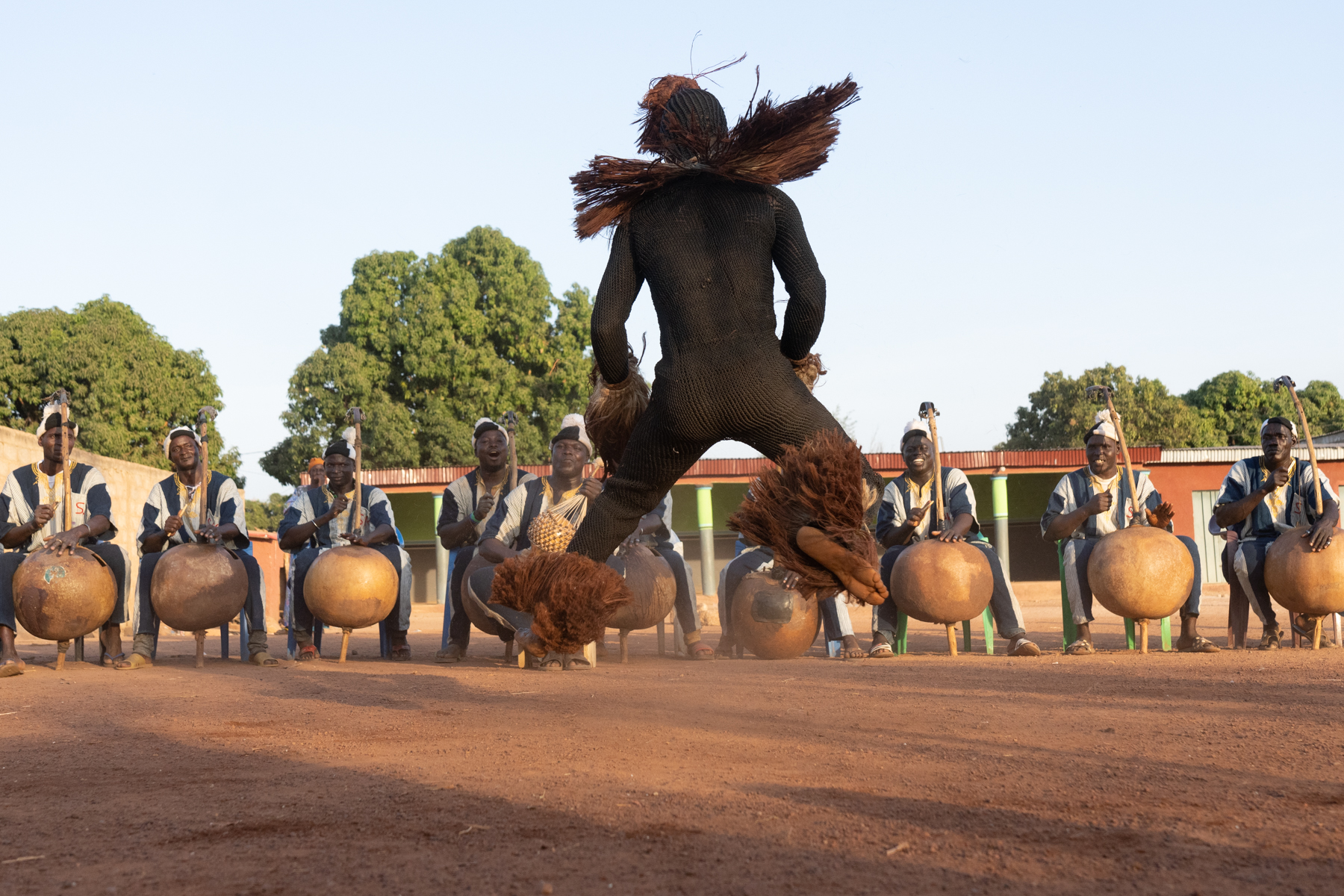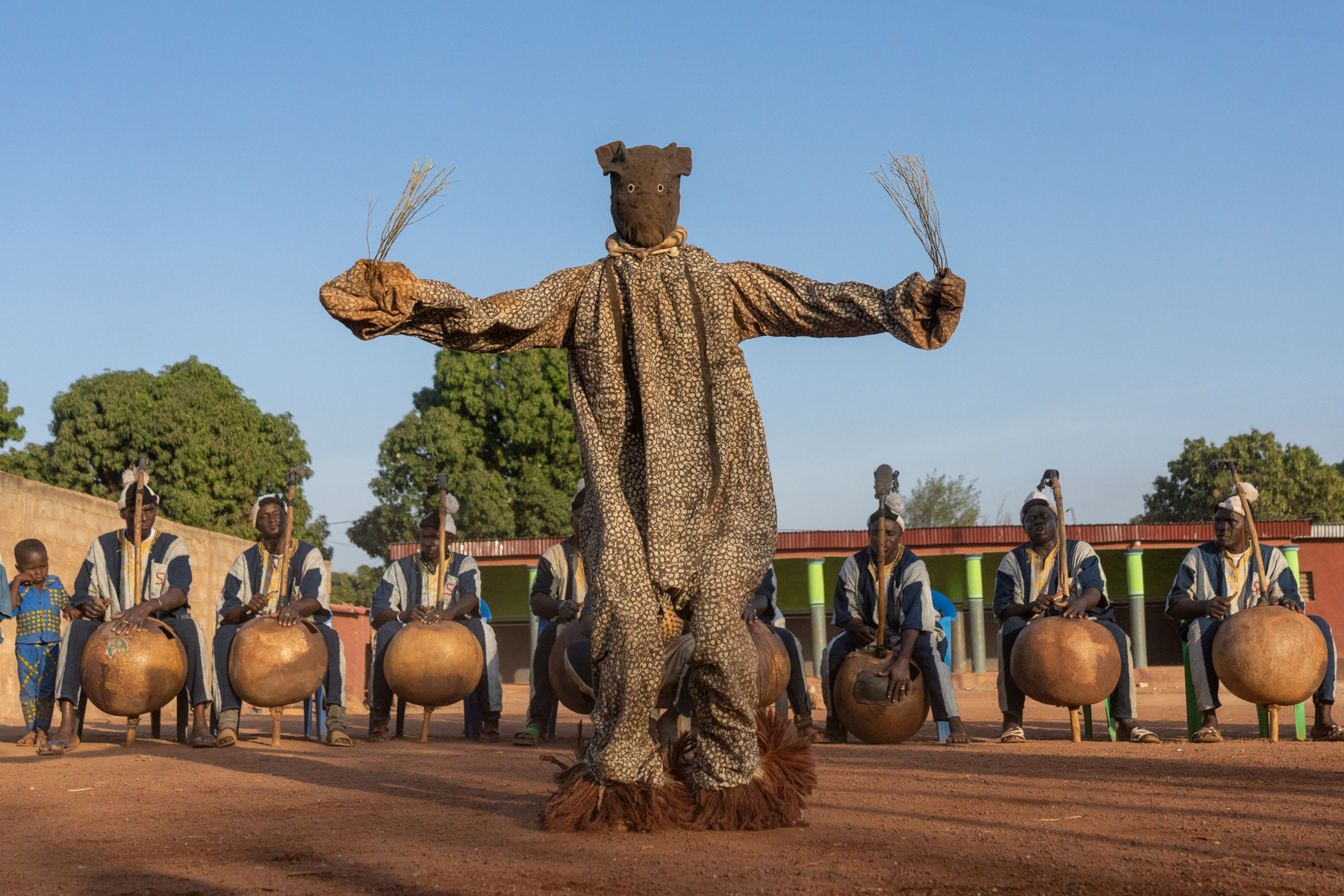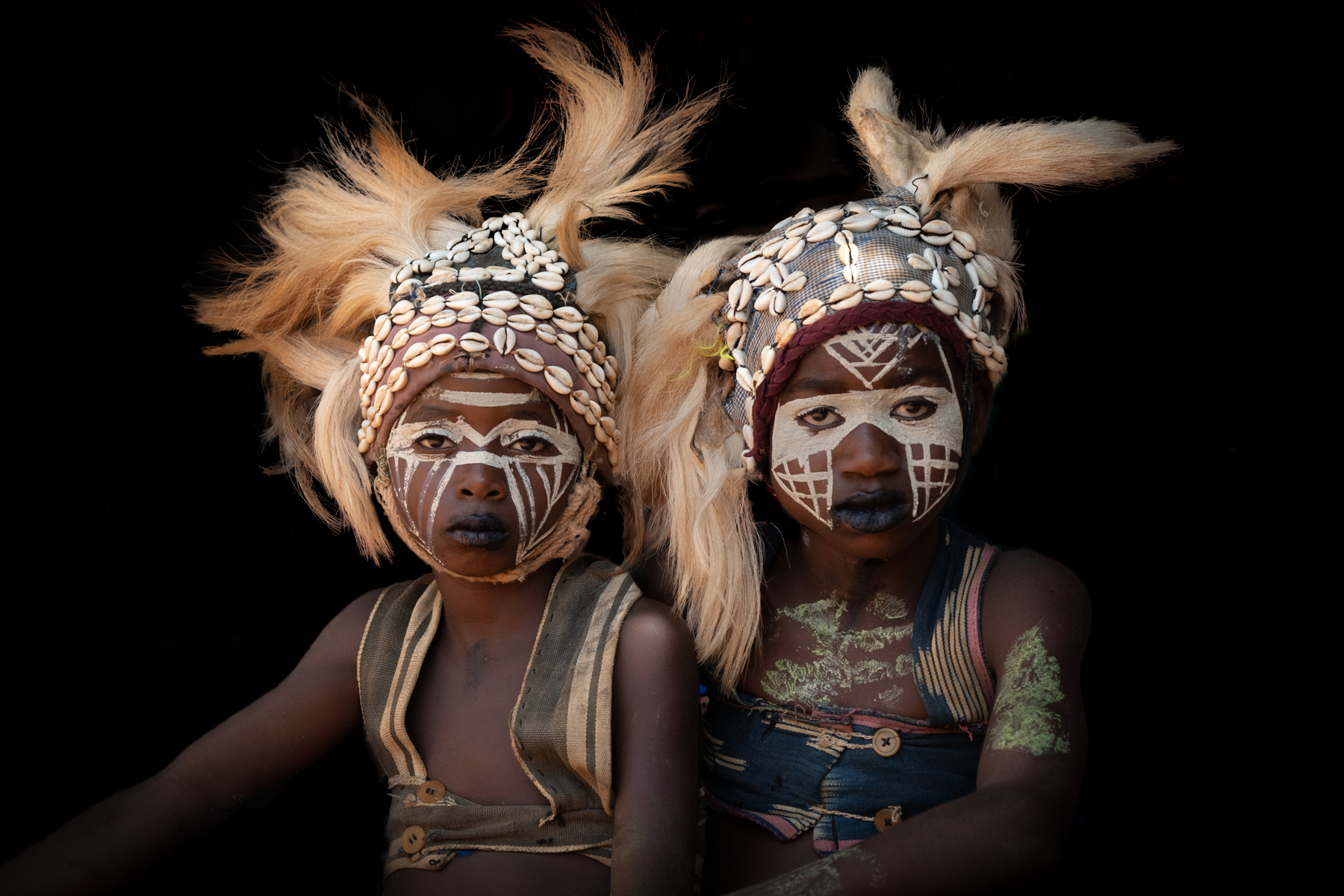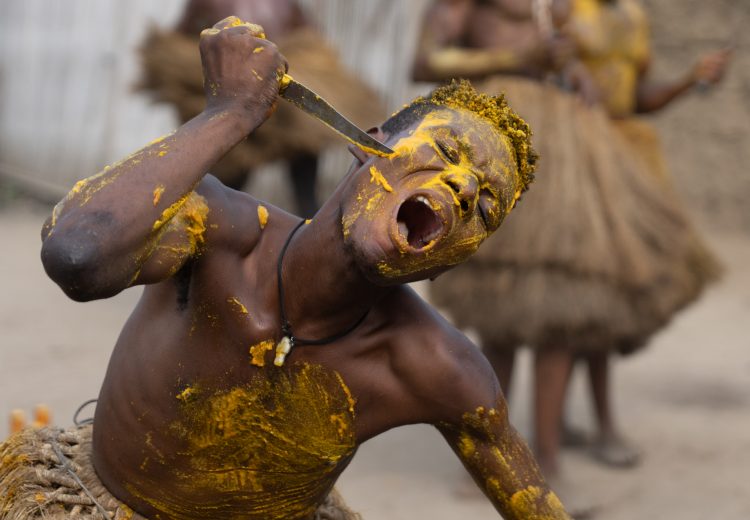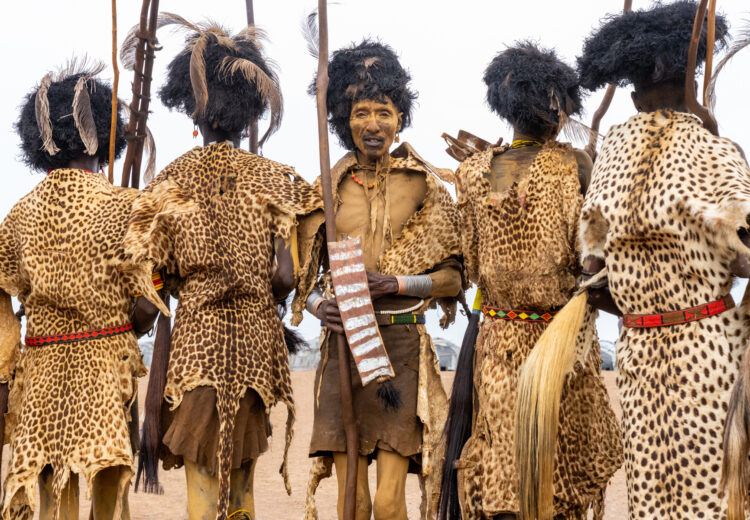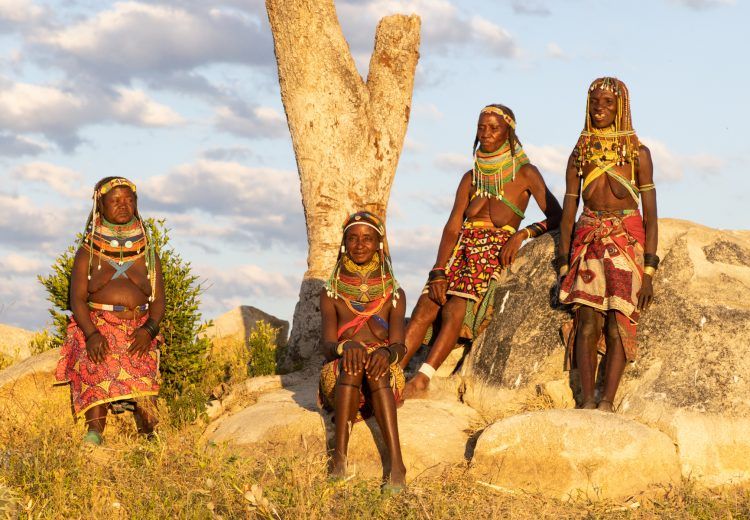Ivory Coast (Côte d'Ivoire)
IVORY COAST: Land of Masks and Dance

















































































































































































































Just your typical street scene on the road in Ivory Coast (image by Inger Vandyke)

Inside the Komian shrine (image by Inger Vandyke)

A rare, behind the scenes meeting with a Zaouli dancer. It takes seven years for these young men to learn a Zaouli dance and they are revered almost as gods by the Guro people who have Zaouli as part of their tradition (image by Inger Vandyke)

The simple fun of using strands of kelp as skipping ropes. Children of Grand Bassam's fishing community, N'Zima, play on the beach and in the surf (image by Inger Vandyke)

Entrance door to the 12th century Grand Mosque in Kong (image by Inger Vandyke)

Entrance portal to Ganamet house in Grand Bassam (image by Inger Vandyke)

Muslim women at Missiridena, the women's mosque of Kong (image by Inger Vandyke)

The stunning beauty of Kong's Grand Mosque (image by Inger Vandyke)

A selection of hand made and hand painted beads in Korhogo (image by Inger Vandyke)

The magical Wambelé (image by Inger Vandyke)

Detail of the Sahelian adobe minarets at the Grand Mosque of Kong (image by Inger Vandyke)

Behind the scenes with a group of Komian women as they prepare to dance (image by Inger Vandyke)

Portrait of a Balafon musician (image by Inger Vandyke)

Godoufou taking in the sunset (image by Inger Vandyke)

Streetlife in Kong, northern Ivory Coast (image by Inger Vandyke)

A typical hairdresser in the street market at Man (image by Inger Vandyke)

A woman carrying a large gourd near the doorway of Missiridena, the small women's mosque of Kong (image by Inger Vandyke)

A pair of Balafon dancers with their beautiful hats fashioned out of sisal and ostrich feathers (image by Inger Vandyke)

Koma and his guardian pause before returning to the sacred forest (image by Inger Vandyke)

Zaouli dancing with his guardian (image by Inger Vandyke)

Local Senufo people dance in circles to celebrate the Balafon (image by Inger Vandyke)

Portrait of a young Balafon musician (image by Inger Vandyke)

A young girl with her baby sister in front of hanging Korhogo cloth (image by Inger Vandyke)

A spinning Goly dancer (image by Inger Vandyke)

A Komian with her makeup of kaolin powder, an essential decoration for dance (image by Inger Vandyke)

Built in Sahelian style and dating back to the 12th century, the Grand Mosque of Kong is a beautifully preserved mosque that is reminiscent of those over the border in Burkina Faso and Mali (image by Inger Vandyke)

A Komian dancer in a cloud of Kaolin powder during a ceremony (image by Inger Vandyke)

A beautiful Sooty Mangabey at the monkey sanctuary in Man (image by Inger Vandyke)

Local art in the ruined artists' building at Grand Bassam (image by Inger Vandyke)

Gba in hiding (image by Inger Vandyke)

Hanging out with the locals of N'Zima at Grand Bassam (image by Inger Vandyke)

A Dozo man licks a live ember during a medicinal / healing demonstration (image by Inger Vandyke)

Ivoirean fishing boats ply the waters off Grand Bassam (image by Inger Vandyke)

Gba pouring a libation in the soil. Afterwards we were invited to daub our foreheads with the mud as a blessing (image by Inger Vandyke)

Prior to the arrival of Senufo virgins at the dance of N'Goro, a group of young men in white tasseled trousers dance to announce their arrival (image by Inger Vandyke)

Guardians of Yacuba Gla performers often shout commands as part of their performance (image by Inger Vandyke)

The magical Wambelé (image by Inger Vandyke)

A young Guéré girl waits her turn to dance (image by Inger Vandyke)

Shea Butter seeds must be washed thoroughly before they are boiled (image by Inger Vandyke)

The Mont Sienlow sacrificial rock is the most prominent of its kind in Ivory Coast (image by Inger Vandyke)

Portrait of a fortune teller at Mont Sienlow (image by Inger Vandyke)

Brightly coloured materials used to make clay beads. The paints are all natural and area created from local ochres, leaves and fruits (image by Inger Vandyke)

A Boloye dancer launches into a somersault (image by Inger Vandyke)

Portrait of a beautiful Ivoirean girl on the street in Kong (image by Inger Vandyke)

Detail of the Dozo funerary dress. It is made from leather, stitched with cowrie shells (image by Inger Vandyke)

Portrait of a Dozo man with protective amulets (image by Inger Vandyke)

Portrait of a Boloye dancer (image by Inger Vandyke)

Aerial view of a traditional Yacouba village with modern buildings creeping in (image by Inger Vandyke)

A young Guéré girl decorated for the Dance of the Jugglers (image by Inger Vandyke)

Portrait of an Akan woman who recently had a baby. In Akan tradition new mothers must smear their bodies with shea butter for the week after birth (image by Inger Vandyke)

The incredible Zaouli dance of the Gouro people in Ivory Coast (image by Inger Vandyke)

The breathtaking stature of a Dozo head man (image by Inger Vandyke)

Koma in action (image by Inger Vandyke)

A young woman working at a Shea Butter plant in Korhogo (image by Inger Vandyke)

Niofoin villages feature a collection of stilted granaries, round houses made from mud bricks and fetish houses as a centre point of worship (image by Inger Vandyke)

An elderly Senoufo woman spinning cotton in the door of her home (image by Inger Vandyke)

Portrait of a Boloye kora player in Korhogo (image by Inger Vandyke)

The hands of a fortune teller at Mont Sienlow (image by Inger Vandyke)

Beautiful young girls at Kong (image by Inger Vandyke)

The mysteries Wambelé, or the sorcerer in Senoufo culture (image by Inger Vandyke)

Portrait of a Dozo elder (image by Inger Vandyke)

Portrait of an elderly Senoufo blacksmith (image by Inger Vandyke)

Street photography in N'Zima fishing village at Grand Bassam (image by Inger Vandyke)

A Wambelé dancer stops beside his mask before imbuing it with magic (image by Inger Vandyke)

Portrait of a muslim woman with a large gourd at Kong, northern Ivory Coast (image by Inger Vandyke)

A pretty young girl selling beach toys for children at Grand Bassam (image by Inger Vandyke)

A Komian dancer in mid-dance (image by Inger Vandyke)

Elders sit to oversee a stilt dance in the village of Godufu (image by Inger Vandyke)

Missiriba is one of the best preserved mud mosques outside of Mali in Africa (image by Inger Vandyke)

Goly dancers standing with their guardian dressed in the traditional Kita fabric of the Baoulé people (image by Inger Vandyke)

Portrait of a Zaouli Sortanvani mask. It features a wooden loom to symbolise weavers in Guro culture (image by Inger Vandyke)

Mid-air Boloye Dancer (image by Inger Vandyke)

A beautiful smiling Fulani girl in the door of her home (image by Inger Vandyke)

Portrait of a lady selling traditional medicinal plants at the street market in Man (image by Inger Vandyke)

Gla dancer of the Guéré people in remote Ivory Coast (image by Inger Vandyke)

Portrait of a Dozo head man in remote Ivory Coast. The Dozo are a fraternity of hunter gatherers living in Ivory Coast, Liberia, Mali and Burkina Faso (image by Inger Vandyke)

A young Dozo man in attendance at N'Goron, the ceremony of fire for young Senoufo virgins (image by Inger Vandyke)

The wild and fascinating Dance of the Jugglers in remote Ivory Coast (image by Inger Vandyke)

A crazy Boloye dancer puts on a wild act in Ivory Coast (image by Inger Vandyke)

Detail of a Goly dancer's hands (image by Inger Vandyke)

A typical village scene in Yacouba territory (image by Inger Vandyke)

Building detail in Grand Bassam. A UNESCO World Heritage site, the original French colonial buildings of Grand Bassam are listed for their important history of French trading posts in the Gulf of Guinea (image by Inger Vandyke)

A Dozo man at the base of a sacred rock in remote Ivory Coast (image by Inger Vandyke)

Dozo musicians with their traditional Bolon musical instruments (image by Inger Vandyke)

A pretty Komian woman jokes with the guests on our tour from the door of her home (image by Inger Vandyke)

Young men contemplate a night of sea fishing from their pirogues at Grand Bassam (image by Inger Vandyke)

Too close for comfort? A Boloye lands right in front of us during a dance (image by Inger Vandyke)

A spinning Godoufou stilt dancer chases the crowd into the dust (image by Inger Vandyke)

Of all the dances we see on our tour, Zaouli is one of the most riveting (image by Inger Vandyke)

A Zaouli dancer takes flight during an athletic jump as part of his performance (image by Inger Vandyke)

Inside Missiriba, which is open to both men and women for prayer (image by Inger Vandyke)

A group of Senufo virgins wait for the next act of the N'Goro, or Fire Dance (image by Inger Vandyke)

Visiting a Fulani village and meeting such warm and friendly people is always a highlight of tours in West Africa (image by Inger Vandyke)

Looking through the adobe window to the administration building of the ancient Grand Mosque in Kong (image by Inger Vandyke)

A parade of Gla masked dancers of the Yacuba people in remote Ivory Coast (image by Inger Vandyke)

Children of Grand Bassam's fishing community, N'Zima, grow up in a world of fresh fish, colourful pirogues, surf beaches and summer rains (image by Inger Vandyke)

A pair of Goly Masked Dancers called Goli Glan with their guardian. Their masks are mixed symbols of crocodile and antelope (image by Inger Vandyke)

A group of masked Boloye dancers take a break between performances (image by Inger Vandyke)

"Is it my turn yet?" young Guéré girls waiting for the prompt to perform in the Dance of the Jugglers (image by Inger Vandyke)

A cheeky Green Monkey at the sanctuary in Man (image by Inger Vandyke)

Zaouli in the clouds (image by Inger Vandyke)

Hats and swimsuits for sale to beach goers in Grand Bassam (image by Inger Vandyke)

Seated Wambelé dancer with his mask. It is unusual to see who is behind the masked dancers of West Africa. Wambelé is the exception (image by Inger Vandyke)

The whip master sitting in a live fire at the ceremony of N'Goron (image by Inger Vandyke)

Goly dancers with their spectacular raffia costumes (image by Inger Vandyke)

The mask of Zaouli Zohoulin. This important Zaouli mask features a chicken eating a lizard, a symbol dating back to the time the Guro engaged in an idealogical war and succeeded (image by Inger Vandyke)

Buying antiques in the old quarter of Bassam is a very special experience (image by Inger Vandyke)

Detail of an old French colonial building in Grand Bassam (image by Inger Vandyke)

Goli glan masked dancers of the Baoulé people (image by Inger Vandyke)

Portrait of an N'Goro Fire Dancer (image by Inger Vandyke)

Watching Zaouli is an absolute highlight of our tour. A UNESCO listed dance for its cultural significance, it is one of the most mesmerising performances in West Africa (image by Inger Vandyke)

A local weaver takes a break from making textiles in Korhogo (image by Inger Vandyke)

A pair of Goly Kpan dancers of the Baoulé people (image by Inger Vandyke)

Street photography in Ivory Coast is not only simple but beautiful. Just be prepared to have as many photos taken of you as you will take with friendly locals! (image by Inger Vandyke)

A young Senufo girl watches a performance of Balafon dancers near Korhogo (image by Inger Vandyke)

The fishing village at Grand Bassam. With luck it will be protected as part of the UNESCO listing for the area and not ruined by modern development (image by Inger Vandyke)

The oddly shaped stilted granaries of the Niofoin (image by Inger Vandyke)

Close up of a Goly mask (image by Inger Vandyke)

Senoufo virgins at N'Goron ceremony in remote Ivory Coast (image by Inger Vandyke)

A beautiful Ivoirean girl selling pineapples in the ruined ground floor of Grand Bassam's Ganamet House, one of the most iconic buildings of this former French trading outpost on the Gulf of Guinea (image by Inger Vandyke)

The master of ceremonies at an N'Goro Fire Dance. He's sitting in a live fire holding a live ember as part of his act (image by Inger Vandyke)

Komian women dowse themselves in kaolin powder to prepare for a ceremony (image by Inger Vandyke)

A proud grandmother watches over her grandkids playing in the N'Zima fishing village of Grand Bassam (image by Inger Vandyke)

Head stands are also part of the Boloye dance (image by Inger Vandyke)

Wood detail of an ageing door on one of the French colonial buildings in Grand Bassam (image by Inger Vandyke)

The turret of Missiriba (image by Inger Vandyke)

Portrait of a Zehego Gla (mask) dancer. Zehego is the mask of the chameleon in the Yacuba people of Ivory Coast (image by Inger Vandyke)

The youngest Panther dancer struts his stuff at a performance of Boloye (image by Inger Vandyke)

Goly masked dancers with their bushbuck skins (image by Inger Vandyke)

Portrait of a decorated Jongleurs girl (image by Inger Vandyke)

Motion blur of a Zaouli, one of Africa's most famous dancers (image by Inger Vandyke)

Smeltering ore in the workshop of a local Senufo blacksmith (image by Inger Vandyke)

Before it is played at a Balafon ceremony, the skin of a drum is 'cured' over an open fire (image by Inger Vandyke)

The tools of the Komian dance (image by Inger Vandyke)

A Senufo blacksmith shakes his ore free of detritus before sending it to a traditional blast furnace (image by Inger Vandyke)

A Senoufo blacksmith shows us how he picks up metal from the earth using a magnet (image by Inger Vandyke)

A Zaouli Gan mask that symbolises the horns of prey animals like antelope and how they protect themselves from hunters (image by Inger Vandyke)

Sunsets on the beach at Grand Bassam are stunning (image by Inger Vandyke)

She sells steel wool on the street side. A young girl carries her curious stock of trade on her head at the street market in Korhogo (image by Inger Vandyke)

Detail of a Gla mask (image by Inger Vandyke)

Portrait of a young We, or Guéré, girl dressed up for the Dance of the Jugglers (Danse des Jongleurs) (image by Inger Vandyke)

There is no monument to slavery in Grand Bassam. Locating the headquarters of where it happened requires some local knowledge as the building now sits crumbling in the forest (image by Inger Vandyke)

The youngest Boloye performer watches his fellow dancers while he waits for his turn in the performance (image by Inger Vandyke)

One of the murals adorning the home of Ivory Coast's Komians (image by Inger Vandyke)

Goli Kpan masked dancer (image by Inger Vandyke)

Rafters made of saplings line the ceiling of Missiriba, the Grand Mosque of Kong (image by Inger Vandyke)

Fulani children are so very pretty (image by Inger Vandyke)

Portrait of a Dozo woman (image by Inger Vandyke)

Hilarious Gla dancer posing for us on tour (image by Inger Vandyke)

A bunch of children play with makeshift toys in the surf on the beach at Grand Bassam (image by Inger Vandyke)

Dressed in black, a Boloye dancer takes flight during the ceremony of the same name (image by Inger Vandyke)

Hand painted cloth for sale in Grand Bassam (image by Inger Vandyke)

One of the liveliest dances we see on our tour, Boloye dancers have a series of highly athletic moves! (image by Inger Vandyke)

Young Senoufo men dancing at N'Goron (image by Inger Vandyke)

Masks play an important role of helping the culture of the Yacuba people to survive (image by Inger Vandyke)

The crazy Gla dancers of Ivory Coast's Guéré people (image by Inger Vandyke)

The wildest master of ceremonies oversees the N'Goro Dance. Not only does he dance barefoot in an open fire he chews on live embers in between cracking a long whip to keep the audience entertained! (image by Inger Vandyke)

The ceiling inside the gigantic Basilica of our Lady of Peace in Yamoussoukro. The largest Christian church in the world, its dimensions are bigger than the Vatican (image by Inger Vandyke)

The head girl of the Godoufou. Her role is to prepare young Yacouba girls for their deportment (image by Inger Vandyke)

Portrait of a beautiful young Senufo virgin with her dancing poms made from raffia and paper (image by Inger Vandyke)

Fashioned from local timbers, these sophisticated looms are used to create beautiful textiles in Korhogo (image by Inger Vandyke)

Local children enter the Boloye dance arena showing off their moves before the performers arrive for the main act (image by Inger Vandyke)

A young member of the local fishing community of N'Zima in Grand Bassam (image by Inger Vandyke)

A pair of Komian women, pretty in pink (image by Inger Vandyke)

Midday is a time for mothers to sleep but babies never do! (image by Inger Vandyke)

Beautiful Goly dancers of the Baoulé people in Ivory Coast (image by Inger Vandyke)

Gla guardian of the Yacuba people in a forest adjacent to his village (image by Inger Vandyke)

The home complex of the Niofoin Fetish houses include a building for cooking (centre) and a Kafodan, or meeting building (left) (image by Inger Vandyke)

A pretty young girl selling peanuts at a street market in Man (image by Inger Vandyke)

Sunset through the coconut palms on the beach at Grand Bassam (image by Inger Vandyke)

A Jongleurs dancer sitting in the crowd at her ceremony (image by Inger Vandyke)

A beautiful Komian girl in blue (image by Inger Vandyke)

A local lady passes by the Grand Mosque of Kong after shopping for yams in the local market (image by Inger Vandyke)

Portrait of a beautiful Komian in Annasiué (image by Inger Vandyke)

The facade of charismatic Ganamet House is slowly being consumed by strangler figs. Once the home of a Lebanese coffee and cocoa trader of the same name, Ganamet house is a fine example of the crumbling French colonial buildings of Grand Bassam (image by Inger Vandyke)

A young lady of Aniassué assists a Komian dancer in preparing for her dance (image by Inger Vandyke)

Balafon performers (image by Inger Vandyke)

Boloye with his ceremonial twigs (image by Inger Vandyke)

Komian dancer on white (image by Inger Vandyke)

A local woman takes a break in the fish market of Abidjan (image by Inger Vandyke)

Dozo musicians and their koras at the base of their sacred mountain (image by Inger Vandyke)

The small and beautiful ancient mosque of Missiridena (image by Inger Vandyke)

One of the stick musicians performing at the ceremony of Gba (image by Inger Vandyke)

A fetish assistant cooks a sacrificed animal from earlier that day. Across West Africa, animals that are sacrificed are generally eaten (image by Inger Vandyke)

A Senoufo virgin wtih traditional headdress at the ceremony of N'Goron (image by Inger Vandyke)

Amazing Gba. He was a group favourite during our tour (image by Inger Vandyke)

Stunningly decorated Jongleurs girls (image by Inger Vandyke)

A pretty young girl selling sandals and clothes at the street market in Korhogo (image by Inger Vandyke)

Yacouba head woman in attendance at the stilt dance of Godoufou (image by Inger Vandyke)

A line up of young Senufo men at the dance of N'Goro, or the Fire Dance (image by Inger Vandyke)

A ball of indigo-dyed natural cotton sit waiting to be woven into fabric at Korhogo (image by Inger Vandyke)

Islamic door detail at Missiriba, the Grand Mosque of Kong (image by Inger Vandyke)

A Zaouli dancer of the Guro people in Ivory Coast (image by Inger Vandyke)

A Niofoin fetish assistant poses proudly in front of the door of a Niofoin fetish house (image by Inger Vandyke)

A selection of masks for sale in Korhogo (image by Inger Vandyke)

Musicians serenade a solo Goli Kpan masked dancer into the arena (image by Inger Vandyke)

A Komian pauses for a moment during her dance. She is standing in front of a wall mural that tells of Komian tradition in the Ivory Coast (image by Inger Vandyke)

Dozo men take a break in the shade of a sacred rock (image by Inger Vandyke)

A Wambelé dancer at his ceremony (Image by Inger Vandyke)

During the Dance of the Jugglers young Guéré girls are tossed into the air before being expertly caught and landed into safety (image by Inger Vandyke)

After making a sacrifice you can visit fortune tellers to find out if your wishes will come true at Mont Sienlow (image by Inger Vandyke)

A small group of Touboubele fetish dolls greet the faithful at the sacrificial rock of Mont Sienlow (image by Inger Vandyke)

Boloye musicians play a mixture of Kora and Maracas, both made from calabashes, at a performance of Boloye, the Panther dance (image by Inger Vandyke)

Koma takes a rest between stints of amusing the crowd at Godoufou (image by Inger Vandyke)

A Senufo blacksmith showing his newly made axe in his workshop (image by Inger Vandyke)

The selection of masks for sale at an obscure shop in Man (image by Inger Vandyke)

An Ivoirean man drives his rice manufacturing equipment into town at Boundiali (image by Inger Vandyke)
|
Monday 10th November –
Sunday 23rd November 2025 Leaders: Inger Vandyke and a local cultural guide |
14 Days | Group Size Limit 6 (1 space) |
|
Tuesday 10th November –
Monday 23rd November 2026 Leaders: Wild Images to be announced and a local cultural guide |
14 Days | Group Size Limit 6 |
IVORY COAST – LAND OF MASKS AND DANCE PHOTOGRAPHY TOURS WITH WILD IMAGES
West Africa’s Ivory Coast (Côte D’Ivoire) is one of the greatest hidden gems of African culture on the continent. It is home to around sixty different cultures, all of which are woven together in an intricate tapestry of animism, voodoo and the ancient tradition of African masks. Wild Images is proud to pioneer Ivory Coast photography tours in this exciting, yet little visited, West African country.
For years the civil wars in Ivory Coast blocked off tourism to the outside world. When these wars ended in 2011, Ivorian people began to live in peace and their country has had very few problems since. While tourism is very much in its infancy, for intrepid photographers who really want to experience uniquely beautiful African cultures, visiting Ivory Coast is a sensual journey of photographic art, great food, ancient monuments and wild, fascinating African masked dances.
During our tour we will experience one of Africa’s most famous cultural performances, the Zaouli, a uniquely Ivorian dance that has been listed as an act of cultural significance by UNESCO and the athletic performances of the Senufo people including Boloye (the Panther dance), Gla, N’Goro (the Fire Dance), Balafon and the Danse des Jongleurs (the Dance of the Jugglers). Other wildly fascinating dances we will see are the dance of the Komians, some of West Africa’s most famous traditional healers, the forest-born stilt dance of the Godoufou people and the masculine/feminine spirit dance of Goly with the Baoulé people.
We will visit the largest Christian Basilica in the world at Yamoussoukro and two of the best preserved mud mosques outside Mali, in the ancient trading city of Kong. Departing from these monotheistic faiths we will explore the animist monuments of the Niofoin Fetish houses and the sacred sacrificial rock at Mont Sienlow.
Ivory Coast is also home to a talented variety of artisan weavers, sculptors, bead makers and music that will all feature heavily on our tour.
Finally, we will wander through lively bustling markets and visit some of the crumbling old French colonial houses and fishing villages of Grand Bassam for some beautiful and spontaneous street photography.
THE TRADITION OF MASKS IN IVORY COAST
Ivory Coast is perhaps the most iconic West African country in terms of mask diversity and beliefs. If you are a collector of masks, or if you have seen African masks for sale across the African continent or overseas, there is a very good chance that many of the masks you have admired will have either been directly made in or inspired by those stemming from the Ivory Coast. Carefully crafted and spectacular, masks that are worn by dancers across West Africa are usually accompanied by headdresses, costumes and musical instruments that transform the wearer from an ordinary person into someone who has been taken over by the spirits.
Protectively shrouded when not in use, some of the masks we will see emerge in full force at dances that are performed for a variety of reasons including channelling the divine, consulting with ancestral wisdom, escorting the departed, celebrating the living or marking the natural cycles of existence. They may also accompany young men and women on their initiation rituals.
It is strictly forbidden to touch them if you are uninitiated and almost all masked dancers are accompanied by a guardian to protect onlookers from accidental contact and also guide the masked dancer through his spiritual routine.
Learning about Ivorian cultures through the various dances of our tour is truly a mesmerising experience.
KOMIANS
Unique to the Akan culture of Ivory Coast and Ghana, Komians are the most celebrated traditional healers in the country. Komians are not only consulted for their knowledge of medicinal plants but also for their “power” to ward off evil and predict the future. Without their intervention, no enthronement of a king or chief can take place.
We will travel to a traditional centre for Komian training in the small town of Anassiué to witness their traditions and beautiful circular dance which is performed to the music of tam tam drums and bells.
ZAOULI
A relatively recent addition to the cultures of Ivory Coast, the spectacular dance of Zaouli has rapidly become one of the best known cultural performances in Africa. On average it takes a Zaouli dancer around seven years to perfect his craft and once he becomes a master, he is able to perform the wildest dance of masks whereby his upper body remains still while his feet and legs zigzag their way through a dance. Performed mostly for funerals and celebrations by the Gouro people, Zaouli is danced only by men and usually by members of the same family.
Young dancers are revered as part of Guro society and watching them dance, even in plain clothes is a true highlight of our tour. Once a dancer graduates to a fully costumed performer he will don colourful tights, leg poms, bells and one of several symbolic masks depending on the meaning of the celebration.
GOLY
Ivory Coast’s Baoulé people are a sub-culture of the Akan people and the powerful Ashanti kingdom that once spread across West Africa from its homeland of Ghana. They are best known for their beautiful handwoven Kita fabric that is spun in a similar way to Kente cloth in Ghana.
We will visit a Baoulé community to learn about their tradition of Goly through special masked dances that are often performed during celebrations or funerals. These twinned masks appear as almost identical but they are representative of the male and female spirits that exist within all of us. It is possible we will see two different styles of Goly mask on our tour including Kpan, or human faced masks and Glan masks which are inspired by a mythical creature that is a cross between an antelope and a crocodile.
BOLOYE – THE PANTHER DANCE
As we travel deeper into the country we will enter the lands of the Senoufo people, an ethnic group that is now found mostly in Ivory Coast, Burkina Faso and Mali. Senufo people are the most culturally rich people we will meet on our tour and a highlight of learning their culture will be attending a Boloye, or Panther Dance.
Senoufo people believe that the spirit of a deceased person will still wander their village long after they have died so, fearing that these deceased spirits might bring ills to their community, they exorcise the spirits through a long funeral rite in order to send their spirit into the afterworld.
A key part of this funeral rite is the dance of the Boloye, or Panther.
Although their society is matrilineal, young Senoufo men undergo a twenty-year training at a forest school called Poro, before they are initiated into a highly secretive men’s society. On the last day of a Senoufo funeral, a young Poro initiate is tasked with leading masked dancers called Nufori into the arena. These dancers are masked in a costume fashioned out of traditional dyed mud cloth that has been daubed with paint spots and designed to terrify women and children in the audience as they are normally excluded from these events.
Accompanying them are musicians playing large Bolon instruments and rattles made from local calabashes. The excitement builds as each Nufoir enters the arena and dances an acrobatic series of movements including somersaults, headstands and flips. While it feels like a great source of entertainment., these dancers are both respected and feared by villages at once.
BALAFON
The Balafon of Ivory Coast’s Senoufo people is a pentatonic xylophone fashioned out of natural gourds, or calabashes, carved wood and sisal twine that is constructed around a trapezoidal frame. Used traditionally in all celebrations, Balafon players start to learn their music from a very young age with a small Balafon before they graduate to larger instruments with time. Known locally as Negele, the Balafon is either played singly or as part of an ensemble at festivals, prayer services and funerals of the Senufo.
A performance of Balafon is an act of great appeal to Senufo people who join the musicians in performing a lively, circular dance to the rhythmic strumming of drums and Balafons.
N’GORON – THE DANCE OF FIRE
One of the most spectacular dances we will see on our tour is the Dance of Fire or N’Goron. Performed by the Senoufo people, it is a traditional dance of passage for young Senoufo virgins and it is overseen by a master of ceremonies who, in between dance moves on top of a flaming fire where he picks up live embers and chews on them, cracks a huge whip to keep the audience in check!
It begins with the music of drums and balafons which ring out across the village of the performance. A group of young initiated men wearing white tasselled trousers appear and dance in circles blessing the musicians and visiting dignitaries. Soon after the virgins appear. Naked from the waist up, beautiful Senoufo girls dance their way into the ceremony with poms made from paper and raffia grasses. The rhythm and variety of acts in a performance of N’Goron are both fascinating and infectious leaving the viewer with the feeling of never wanting it to end!
THE STILT DANCE OF GODOUFOU
Lying deep in the countryside near Touba, in a small traditional Yacouba village sits adjacent to a sacred forest. It is here that a community of Dan, or Yacouba, people believe that the spirits of their ancestors reside. These spirits control the fortunes and lives of the living and they must be honoured with sacrifices and masked dances that feature athletic men on stilts up to three metres high.
The ceremony begins with a group of newly married women dressed in white (for purity) and indigo (for self-respect) who sing about the course of married life. Soon after they are joined by elderly women who act as their spiritual guardians.
Later they are joined by a group of young initiated men. While all of this is occurring, a sacrifice is performed in the forest to honour the ancestors of the village and finally, two masked dancers emerge from the forest in a procession towards the village dance. They are Koma and Godoufou and they both perform a series of acrobatic moves to the rhythmic beating of drums. Koma is there to entertain. Godoufou, or the stilt dancer, is there to herald the start of the deportment process for young Yacouba women. This masked creature speaks in a shrill language of tongues that is incomprehensible to outsiders but it gets very excited when donations are offered from the crowd. Performed mostly at sunset, the stilt dance of Godoufu is an exhilarating part of our trip!
DANCE OF THE JUGGLERS (DANSE DES JONGLEURS)
Deep in the forest clad mountains of Man, we will seek out other spectacular dances of the Dan (Yacouba, Guéré, We), a sub-culture of the Senoufo people including the Dance of the Jugglers, one of the oddest performances of our tour. Here young girls are dressed up and placed into a trance before they are tossed into the air and caught safely by an older male performer. The trance emboldens the young girls in their performance, allowing them to fearlessly approach their guardian who twirls them, tosses them and swings them around as part of the act.
GLA
Another performance of the Dan people, Gla is the literal term for ‘mask’. Connecting the living with the spirits of the sacred forest, large masked dancers appear in a performance to celebrate aspects of Dan society. We will see a variety of masks during this performance, each of them guarded by a young man who yells to keep the dancer in control and also to translate the dancer’s language to the crowd. On our first tour, we met three individual dancers – the Zehego (Chameleon), Zeblion (Monkey) and Gambié (Comedian) but many exist and they are brought out depending on the demands of the community on the day.
Much celebrated for their art and export globally Dan masks are usually carved from timber and they are dressed in a variety of costumes including long strands of raffia and fabric.
AN ODYSSEY OF ARTS
We will explore some of the deep traditions of art in Ivory Coast including mask carving, weaving, bead making, painting and blacksmith work. Each of these visits gives us a stunning insight into the breadth of talent that exists across the country. From hand-painted beads to wall murals, brass bells and colourful fabric it is very hard to avoid buying artwork in Ivory Coast. These brightly coloured artisan traditions are beautiful to photograph as they form an integral part of the cultural tapestry we will explore during our tour.
MEET WEST AFRICA’S ORIGINAL FOREST HUNTERS – THE DOZO
While they are not classified as an ethnic group, the Dozo are groups of men who wander the forests of Mali, Burkina Faso and Ivory Coast dressed in traditional ‘fatigues’ of brown mud cloth and wearing a series of hand made leather protective amulets called gris-gris, as traditional hunters. They are sometimes found presiding over ceremonies or acting as guards at self-imposed checkpoints on roads in northern Ivory Coast. These fascinating men, who are very hospitable and good-natured, form fraternities called Donzo Ton and they are often viewed by farming or pastoralist neighbours as possessing special power, wisdom, and strength. During our tour, we will visit a community of Dozos to learn more about their fascinating way of life while joining them for a ceremony at their sacred forest and sacrificial rock.
WEST AFRICAN TEXTILES
One of the more elaborate features of artisan work in Ivory Coast is the creation of traditional textiles which are hand-spun and then handwoven on large wooden looms. Cotton has been an agricultural industry in Ivory Coast for over a century and Ivorian weavers in the Senufo people of the north now create stunning local Korhogo cloth at a large weaver community close to the city of the same name. Further south, the Baoulé people weave Kita fabric in a centuries-old tradition that stems from an ancient tradition of the Akan people who are related to the Baoulé culturally.
These beautiful African fabrics join other celebrated textiles in West Africa like Bogolan, or mud, cloth that is made in Mali and also Kente and Adinkra cloth from Ghana.
LAND OF THE SPIRITS
Similar to many other West African countries, the vast array of cultures in Ivory Coast are linked by the monotheistic beliefs of Christianity or Islam which are intertwined with animism and voodoo.
In Ivory Coast monuments to people’s beliefs take on spectacular and ancient forms and during our tour, we will visit four key places of worship for Ivorian people.
THE BASILICA OF OUR LADY OF PEACE
Unbeknownst to many across the globe, the largest church devoted to the Christian faith in the world is actually in the administrative capital of Ivory Coast, Yamoussoukro.
In 1983 the then president of Ivory Coast, Hourphouët-Boigny chose Yamoussoukro to be the new capital of his country. As part of his plan for the city, the president wanted to memorialise himself with the construction of a basilica with a view to it becoming the key pilgrimage site for African Catholics.
Featuring a dome that is twice the diameter of St Peters in Rome it seats up to 7,000 people in the nave with standing room for a further 11,000. While photography is not permitted in many of the areas inside, it is still possible in some areas and visiting the Basilica gives a breathtaking glimpse into the strength of the Catholic belief in Africa.
MISSIRIBA & MISSIRIDENA – THE MUD MOSQUES OF KONG
Thought to date back to the 12th century Missiriba, the largest mosque in the northern city of Kong is a stunning example of the Sudano Sahelian style architecture that is so reminiscent of similar structures over the border in Mali, like the Great Mosque of Djenné. Smaller in size, yet no less impressive, Missiriba is the crowning glory of the city of Kong, a former seat of trade between the Dyula caravan leaders and the animist cultures of the Senoufo and Tyefo people in northern Ivory Coast.
With a quietude that belies its bustling past, the small town of Kong is home to two mud mosques built in the same style, both of which are UNESCO World Heritage Sites.
Wandering around Missiriba, we will spend time photographing its hand-sculpted minarets and architectural detail. If a visit inside is permitted we will explore the numerous prayer caverns while padding quietly along the sandy floors of the mosque’s corridors. Oddly a small colony of Guinean Horseshoe Bats has taken up residence here which is significant considering their listed status as Endangered due to their tiny distribution and fragmented habitat.
We will linger in Kong for a short while enjoying street photography in the street outside the mosque where colourful locals shop for wares in tiny stores or wander in and out of the mosque to pray.
NIOFOIN FETISH HOUSES
In the small town of Niofouin in northern Ivory Coast is one of the country’s most peculiar architectural oddities. It is home to two significant structures, the Niofoin Fetish Houses.
Wandering the local neighbourhood of Niboladala, we will wind our way through paths between traditional mud-brick roundhouses and hand-sculpted, stilted granaries to take photographs and meet with some of the friendly Niofoin locals. Thesekafo paths eventually lead to two mushroom-like buildings that hold roles of significance for the animist beliefs of the local people, the Niofoin Fetish Houses.
Handcrafted in an adobe-style, the roofs of these houses spiral whimsically towards the sky. Instead of being replaced every year with thatched grasses like so many other African structures, the roofs of these two houses are simply added to after each rainy season.
Guarding two fetishes, Diby and Kalegbin, these curious structures each play a role in protecting the people of Niofoin. Each has a house of sacrifice next to them and a kafodan, or public meeting place, in front.
Visiting Diby and Kalegbin gives you a glimpse into the living belief of animism not only in Niofoin but in Ivory Coast as a whole.
MONT SIENLOW SACRIFICIAL SITE
Deep in the foothills of Korhogo, at the end of a road lined with wild cashew trees, lies the peculiar sacrificial site of Mont Sienlow. Located on a large granite koppie, this sacred site is visited by pilgrims who offer sacrifices to animist gods in order to wish for goodwill. The reasons for sacrifice could include more money, a child, a happier marriage or good health.
It is quite a starkly beautiful place with huge granite boulders creating a shrine where animal bones and small hand-carved Touboubele dolls are offered as items to worship
Present at the site is a fetish priest who oversees the sacrifices that take place daily at Mont Sienlow. Accompanying him are also fortune-tellers who, for a small fee, will tell your future using a collection of small cowrie shells.
EXPLORING IVORY COAST’S FRENCH COLONIAL PAST
During the final days of our tour, we will spend time relaxing and doing some street photography around Grand Bassam, the UNESCO World Heritage former French trading outpost on the coast of the Gulf of Guinea. Surf lined beaches and charismatic fishing villages abound here. We will stay at a wonderful lodge right on the beach and enjoy fresh seafood meals in between walking the beach, exploring the work of local artists and visiting some of Grand Bassam’s incredible French colonial buildings, many of which are now sitting in ruin as they are slowly engulfed by time and strangler fig trees.
On an architectural photography walk here we will visit Ganamet house, one of Grand Bassam’s most iconic buildings. The house of a Syrian/Lebanese trader who lived in Grand Bassam to trade coffee and cocoa with the Akan people, Ganamet House has an eclectic mix of French and Middle Eastern architectural features including a mansard roof which is unusual of the Bassam houses. These days it lays open to the elements and is slowly being strangled by figs. We will explore the ruined headquarters of Grand Bassam’s slavery master and other buildings to photograph their beautiful crumbling façades with their curious mix of French and African styles and architectural features.
We will visit the pretty local fishing village of N’Zima in the French Quarter which has a lively fishing community that lives in a labyrinth of grass huts at the foot of ancient coconut palms. It is here we will learn about smoking and drying fish while meeting the friendly locals around the villages and the parked pirogues that ply the waters off Grand Bassam to supply its community with fresh fish every day.
Grand Bassam is also home to some wonderful Ivorian artists so if you wish to purchase anything from African masks, to French antiques, local paintings or other wares this is the perfect way to end our tour.
Why travel to Ivory Coast with Wild Images
Wild Images is the proud pioneer of photography tourism in Ivory Coast. Our inaugural expedition across the country was extremely successful. We attended 8 different masked dances, explored the ancient mud mosque in Kong and hand-sculpted fetish houses at Niofoin in between street photography around lively bustling markets and the crumbling historical buildings of Grand Bassam.
Our leader has over thirty years of experience in Africa and knows West Africa extremely well. We travel to remote villages where we will most likely be the only photographers present at incredible local masked dances. We also believe that the best images come from the photography of people in a two-way situation. We encourage our guests to chat to local people, laugh with them, engage with them and simply enjoy the experience of being immersed in their world. As the body of work from our tour shows, we take the time to pay attention to the tiny things that make Ivory Coast such a special place. While it lacks the spectacularly decorated tribal people of other African countries, it makes up for that lack with some of the most ancient and fascinating ceremonies in West Africa.
Accommodation & Road Transport
Road transport is by minibus.
Accommodation is in very basic yet comfortable hotels.
Walking
The walking on this tour is mostly easy.
Climate
The weather in Ivory Coast will be hot and often humid. There is likely to be a mixture of sunny and overcast conditions. Rain is unlikely.
Photographic Equipment
For most photography of the people in West Africa, a travel lens of around 24-105mm on a full-frame DSLR or mirrorless body will be essential. A wide-angle lens of around 16mm or smaller will be perfect for working with people inside smaller rooms.
If you prefer to photograph people from a distance, then please consider bringing a larger zoom or telephoto lens. It is our experience that sometimes people can feel a bit intimidated by large cameras and lenses so you may wish to bring a smaller sized zoom lens like a 100-400mm which doesn’t appear as intimidating as a large fixed focal length telephoto lens. Such a lens can also be useful for the ceremonies we will attend as you will often be standing in a crowd and a longer lens will allow you to shoot past other onlookers.
If you bring a good quality bridge camera instead of a DSLR or mirrorless it will be best if it has an optical zoom of 18-20x or more, combined with a reasonable wide-angle at the other end of the zoom range.
If you have a phone or tablet that can be used for photography, you may find these quite useful around people. Similarly, if you have a Polaroid camera like the Leica Sofort or an Instax Mini, these are wonderful to have on hand when you spend time with tribal people. If you decide to bring one of these, please bring lots of film with you as the photographs you produce will be quite popular!
Drones are particularly wonderful to use in Ivory Coast and they provide a very unique perspective of life in West Africa. Ivory Coast has very few restrictions on flying drones, however, there are a few limitations you will need to consider when you fly.
If you would like to talk over suitable equipment, please contact our office. We will be happy to advise.
VIEW OUR GUEST’S PHOTOS
Before I went to Ivory Coast, whenever I talked with my friends that I booked a photo tour to Ivory Coast, a lot of them told me not much to see or they do not like West African. By then, I thought I probably had made the wrong decision.
In fact, I spent 14 fantastic days in Ivory Coast with Wild Images tour leader Inger Vandyke and other 3 fellow photographers. The tour itinerary surprised me every day: ceremonies, local markets, mask dances, landmarks, blacksmith factory, shea butter processing, wax block printer, and etc. The trip made me busy every day in shooting photos, learning about different cultures and rich history, and observing local’s daily life. This was an incredible adventure in Ivory Coast, and it goes above and beyond my expectations. Thank you and your team! – Rosalie Wang (guest on our 2023 tour to Ivory Coast). To view a gallery of Rosalie’s beautiful images (in colour and infrared), please click here.
Photographic Highlights
- No less than 10 private ceremonies, offering authentic and stunning photo opportunities of some of West Africa's beautiful Voltaique cultures
- Enjoy a performance of Zaouli, a uniquely Ivorian dance that has been protected as a cultural treasure by UNESCO and is now one of the most famous dances in Africa
- Visit the beautiful and ancient mud mosques of Missiriba and Missiridena at Kong
- Wander around charismatic Senoufo villages with their stilted granaries, Kafodan meeting places and Niofoin Fetish Houses
- Witness the visits of pilgrims to the sacrificial stone at Mont Sienlow
- Marvel at the sheer size and dimensions of the Basilica of our Lady of Peace in Yamoussoukro
- Stroll around the former French colonial buildings doing street photography in Grand Bassam
- Photograph Ivorian artists at work creating masks, textiles, beads and paintings
- Visit a sacred monkey forest in Man, home to endangered species of monkeys including Sooty Mangabeys
- Learn about fish smoking and drying in between photography of the fishing village of N’Zima in Grand Bassam
OUTLINE ITINERARY
- Day 1: Arrive in Abidjan for dinner and an overnight stay
- Day 2: Drive from Abidjan to Abengourou. Visit the palace of King Nana Boa Komassi. Drive to Anniasué and performance of Komians
- Day 3: Travel to Yamoussoukro. Visit the Basilica of Our Lady of Peace. Afternoon performance of Goly
- Day 4: Drive to Korhogo and enjoy a late afternoon visit to Mont Sienlow sacrificial rock and possible Senoufo ceremony
- Day 5: Morning tour to visit the ancient mud mosques of Kong. Afternoon performance of Boloye
- Day 6: Morning excursion to visit the Senufo blacksmiths and artisans of Korhogo. Afternoon performance of Balafon
- Day 7: Travel from Korhogo to Niofoin to visit Fetish Houses and villages. Drive further south to Boundiali. Afternoon visit to a Fulani village and then a sunset performance of N'Goron
- Day 8: Drive south to the city of Odienne and spend the rest of the day with the Dozo hunter fraternity, visiting their sacred forest and sacrificial rock for a ceremony
- Day 9: Travel south to Touba for lunch. Drive to a traditional Yacouba village for a ceremony of Godoufou
- Day 10: Day performances of the Danse des Jongleurs and Gla, afternoon visit to the sacred Monkey forest
- Day 11: Visit mask carvers and sellers in Man, the liana bridge and waterfall. Afternoon ceremony of Gba.
- Day 12: Drive from Man to Bouaflé. Afternoon performance of Zaouli. Drive to Yamassoukro
- Day 13: Travel to Grand Bassam and enjoy an afternoon of street photography in this former French trading post
- Day 14: A full morning of street photography on the beach, at N'Zima fishing villages and in the crumbling colonial buildings of Grand Bassam. Tour ends with lunch and half day stay before an evening flight from Abidjan.
To see a larger map, click on the square-like ‘enlarge’ icon in the upper right of the map box.
To see (or hide) the ‘map legend’, click on the icon with an arrow in the upper left of the map box.
To change to a satellite view, which is great for seeing the physical terrain (and for seeing really fine details by repetitive use of the + button), click on the square ‘map view’ icon in the lower left corner of the ‘map legend’.
IVORY COAST – LAND OF MASKS AND DANCE PHOTOGRAPHY TOUR: PRICE INFORMATION
Wild Images Inclusions: Our tour prices include surface transportation, accommodations, meals, water, all photography, driver and guide gratuities and national reserve entrance fees.
Deposit: 20% of the total tour price. Our office will let you know what deposit amount is due, in order to confirm your booking, following receipt of your online booking form.
TO BOOK THIS TOUR: Click here (you will need the tour dates)
2025: confirmed price £6420, €7690, $8450, AUD12590. Abidjan/Abidjan.
2026: confirmed price £6500, €7790, $8560, AUD12750. Abidjan/Abidjan.
Single Supplement: 2025: £330, €400, $430, AUD650.
Single Supplement: 2026: £330, €400, $430, AUD650.
If you are travelling alone, the single supplement will not apply if you are willing to share a room and there is a room-mate of the same sex available.
This tour is priced in Euros. Amounts shown in other currencies are indicative.
Air Travel To & From The Tour: Our in-house IATA ticket agency will be pleased to arrange your air travel on request, or you may arrange this yourself if you prefer.
IVORY COAST: LAND OF MASKS AND DANCE PHOTOGRAPHY TOUR: DETAILED ITINERARY
Ivory Coast Photography Tour: Day 1
Our Ivory Coast, Land of Masks photography tour starts in the early evening with dinner at our Abidjan hotel. Providing you are arriving at Abidjan International Airport today, a transfer to our hotel will be provided.
Ivory Coast Photography Tour: Day 2
This morning we will drive north to the city of Abengouro, arriving in time for lunch. We will visit the Palace of King Nana Boa Komasi, the head of the Agni people before we drive out to the small town of Aniassué to learn about the resident Komian traditional healers and watch their traditional dance.
Ivory Coast Photography Tour: Day 3
Today we will drive to the beautiful northern city of Yamoussoukro, home to many freshwater lakes (filled with crocodiles!) and the gargantuan Basilica of Our Lady of Peace. After enjoying a lakeside lunch we will make a short tour of the Basilica, the largest place of Christian worship in the world, before we drive out to visit a community of the Baoulé people to visit the weavers of Kita cloth and watch a late afternoon ceremony of Goly.
Ivory Coast Photography Tour: Day 4
This morning we will embark on a long journey to Korhogo we will stop for lunch en-route and then spend the late afternoon visiting the curious sacrificial stone at Mont Sienlow.
Ivory Coast Photography Tour: Day 5
Today we will drive out to visit Missiriba and Missiridena, the beautiful ancient mud mosques of Kong. Built in a Sahelian style that is reminiscent of the mosques in Mali, we will make a tour of these beautiful places and enjoy photography in its surrounding streets before we return to Korhogo. In the afternoon we will watch a performance of Balafon.
Ivory Coast Photography Tour: Day 6
Korhogo is well known for its rich tradition in the arts and today we will visit local Senufo blacksmiths, Korhogo weavers, bead makers and painters during the morning. In the afternoon we will join a local community of Senoufo people to celebrate the dance of Boloye.
Ivory Coast Photography Tour: Day 7
As we journey south towards Boundiali, our first stop will be to visit the traditional village and Fetish Houses at Niofoin. Featuring hand sculpted, stilted granaries and two beautiful ancient Fetish Houses, we will wander a labyrinth of paths doing photography of local Senoufo people, their hand made kafodan meeting houses and the Fetish Houses of Diby and Kalegbin. After lunch we will visit a small community of Fulani people before enjoying a performance of N’Goron, or fire dance of the Senoufo virgins, one of the liveliest dances we will see on our tour.
Ivory Coast Photography Tour: Day 8
This morning we will drive south to the city of Odienne and spend the rest of the day with the Dozo hunter fraternity, the traditional hunter-gatherer societies of Liberia, Mali, Burkina Faso and Ivory Coast. Through visits to their sacred forest and sacrificial rock we will learn about the protector and healer roles of this fascinating culture.
Ivory Coast Photography Tour: Day 9
Today we will drive south from Odienne to the city of Touba where we will stop for lunch. In the afternoon we will travel to a traditional Yacouba village for a spectacular ceremony of Godoufou, the deportment ceremony of young Yacouba women, before we drive to Man.
Ivory Coast Photography Tour: Day 10
On our first full day in Man we will enjoy two traditional dances of the Guéré people. The first is the wildly acrobatic Dance of the Jugglers (Danse des Jongleurs), where young girls are dressed up and placed in a trance. They are then tossed in the air before being expertly caught by their guardian of the dance. The second is Gla, the dance of large masks. Later that day we will return to Man to visit a sacred forest sanctuary with its overly friendly troupe of monkeys.
Ivory Coast Photography Tour: Day 11
This morning we will visit some mask carvers and sellers in Man before we visit the waterfall and bridge of Lianas. Late this afternoon we will be enthralled by a performance of Gba, a Yacouba masked dancer who represents a wood borer and can be considered a harbinger of war!
Ivory Coast Photography Tour: Day 12
Today we will leave Man and drive south to the village of Bouaflé where we will enjoy a performance of Zaouli by the Gouro people. This famous African dance is listed by UNESCO for its importance to Ivorian cultures and is a fantastic way to finish the ceremony aspect of our tour.
Ivory Coast Photography Tour: Day 13
Finally we will drive down to Grand Bassam and enjoy some late afternoon street photography in the crumbling old quarter which is also World Heritage listed. Our final tour dinner will be at our wonderful lodge right on the beach.
Ivory Coast Photography Tour: Day 14
On the last day of our tour we will enjoy a day of street photography and a visit the local fishing village of N’Zima in Grand Bassam. Lunch will be at the beach before a late checkout and evening flight from Abidjan.
Ivory Coast: Land of Masks and Dance Tour Report 2023
Ivory Coast. It is one of Africa’s least-known yet fascinating countries. Having only recently (2011) emerged from a vicious civil war, tourism is in its infancy here. Yet, for those willing to brave the journey, Africa’s Ivory Coast offers a sensory overload of ancient, Voltaique cultures, including some of the continent’s most spectacular masked dances. […]
View Report
Ivory Coast: Land of Masks and Dance Tour Report 2021
In 2021 Wild Images organised its pioneering photo tour of Ivory Coast to gain a greater insight and depth into the cultural treasures the country. Tour leader Inger Vandyke reports on this fascinating tour to one of West Africa’s most fascinating destinations. Ivory Coast (Côte D’Ivoire) is perhaps one of West Africa’s least known and […]
View Report
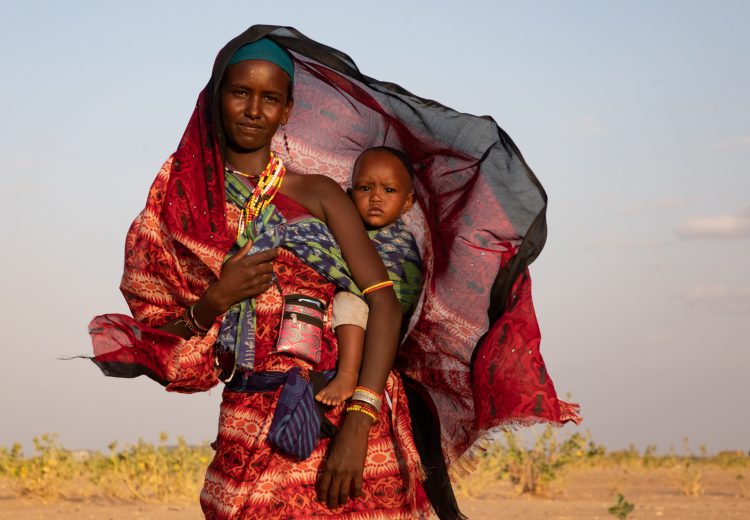
Kenya
August-September 2026





































